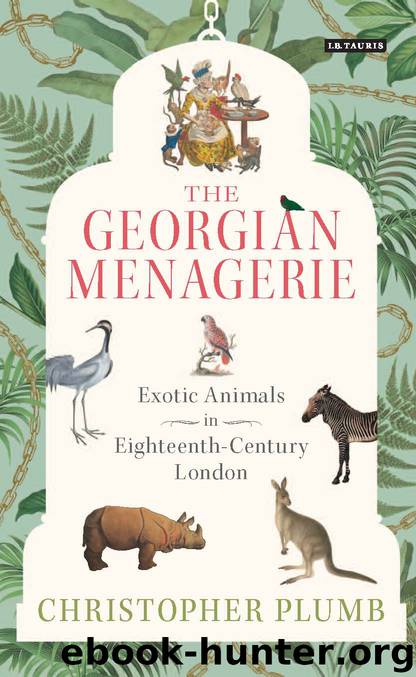The Georgian Menagerie by Christopher Plumb

Author:Christopher Plumb [Plumb, Christopher]
Language: eng
Format: epub
Tags: Georgian Britain, London, Animals and society
Publisher: I.B.Tauris
Published: 2015-06-10T23:00:00+00:00
5 A Lion, James Sowerby (1756–1822), graphite
In spite of the warnings and admonishments of Cowper and other well-meaning sorts, Georgians liked to be familiar with animals, perhaps because close encounters were gratifying to the senses as well as a visceral ‘dicing with danger’ experience. Animals that were quite ferocious were readily approached; the caged leopard at Sir Ashton Lever’s Museum, housed at Leicester House in the 1770s, was ‘gratified by attention and caresses’. And in return, it could be seen ‘purring and rubbing itself against the bars like a cat’. A gratifying experience was a close one, and one in which the animal was responsive.
For this reason a young American visitor to London, Nathaniel Wheaton, recalled the sight of a large box of ‘alligators, crocodiles, and lizards’ on exhibition in a frustrated tone. They were so ‘torpid and sluggish, that they scarcely deigned to move, unless provoked’.5 Boring and dissatisfying encounters were those with unresponsive animals or a lack of interaction. Many spectators, if denied the opportunity to interact by keepers, would make their own fun. Other animal keepers were willing to facilitate hands-on encounters. In both cases, keepers needed to intervene should the worst happen. Two encounters, one from 1811 and the other from 1812, demonstrate the need for keepers to be vigilant. At Miles’s Menagerie in 1811, exhibiting at Bartholomew Fair, a group of lads teased an elephant and attempted to climb on its back. The keeper, eager to show off the tameness of his elephant, had previously suffered to allow them to clamber onto it. However, this time a very unimpressed and displeased elephant spun around and squashed one of the boys against a wall in a ‘very dreadful manner’. The boy, a son of a habit maker, would have surely died had the keeper not run to his rescue. These sorts of accidents were occasionally used as cautionary tales to others. Thus, in 1812 a newspaper reported a tiger mauling with the headline ‘Unfortunate Accident: Caution to Others’. A man had ‘imprudently ventured to touch’ the paw of a tiger, which instantly pounced and after seizing his arm ventured to drag him into the den. Several men tried to liberate the man from the tiger’s jaws and succeeded only by thrusting a stick into the tiger’s mouth. The man was then dispatched to the surgeon, with a ‘dreadfully lacerated’ arm.6
On 19 June 1819 the boys of Dr Charles Orpen’s National Institution for the Education of the Deaf and Dumb Children of the Poor in Ireland visited Polito’s Menagerie, then on tour in Dublin and housed on Lower Abbey Street. The children wrote letters afterwards to recall their memories and to serve as evidence of their progress in moral and practical education. In particular the letters of two boys, William Brennan and Thomas Collins, reveal a great deal about menagerie interactions with exotic animals in the Georgian period. The boys were permitted quite freely to approach the animals and saw other visitors doing so too. After giving his 12 pennies (one shilling) for admittance, William Brennan entered the menagerie.
Download
This site does not store any files on its server. We only index and link to content provided by other sites. Please contact the content providers to delete copyright contents if any and email us, we'll remove relevant links or contents immediately.
The Vikings: Conquering England, France, and Ireland by Wernick Robert(79829)
Ali Pasha, Lion of Ioannina by Eugenia Russell & Eugenia Russell(40086)
The Conquerors (The Winning of America Series Book 3) by Eckert Allan W(36945)
The Vikings: Discoverers of a New World by Wernick Robert(36894)
Cecilia; Or, Memoirs of an Heiress — Volume 1 by Fanny Burney(32385)
Cecilia; Or, Memoirs of an Heiress — Volume 3 by Fanny Burney(31759)
Cecilia; Or, Memoirs of an Heiress — Volume 2 by Fanny Burney(31727)
Empire of the Sikhs by Patwant Singh(22912)
The Secret History by Donna Tartt(18770)
Hans Sturm: A Soldier's Odyssey on the Eastern Front by Gordon Williamson(18436)
Cat's cradle by Kurt Vonnegut(15113)
Pimp by Iceberg Slim(14234)
Sapiens: A Brief History of Humankind by Yuval Noah Harari(14172)
Talking to Strangers by Malcolm Gladwell(13144)
Norse Mythology by Gaiman Neil(13140)
Leonardo da Vinci by Walter Isaacson(13114)
4 3 2 1: A Novel by Paul Auster(12234)
Underground: A Human History of the Worlds Beneath Our Feet by Will Hunt(11986)
The Radium Girls by Kate Moore(11877)
